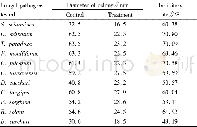《Table 2–Differential response of CBB pathogens to selected resistance QTL in different genetic back
 提示:宽带有限、当前游客访问压缩模式
提示:宽带有限、当前游客访问压缩模式
本系列图表出处文件名:随高清版一同展现
《Diversity and interaction of common bacterial blight disease-causing bacteria(Xanthomonas spp.) with Phaseolus vulgaris L.》
Although variation in virulence has been observed among CBB isolates,differential pathogenicity on different common bean genotypes based on compatible versus incompatible reactions has not been confirmed[14,21–23].Interaction of P.vulgaris with CBB pathogens has been shown largely not to follow the gene-for-gene model[22,24].However,gene-for-gene interactions were observed in tepary bean(P.acutifolius A.Gray),a close relative of common bean[22].It was further observed that this gene for gene interaction is non-specific in the P.vulgaris background.In Ugandan and Ethiopian isolates,Opio et al.[22]observed eight distinct CBB responses on seven tepary bean genotypes(Table 1)and 90%of the tested isolates induced symptoms on each of the 20 bean genotypes tested.In South Africa,Fourie et al.[25]observed that the pathogenicity of all but one isolate was similar to that of race 2,implying limited CBB pathogen diversity.However,variation in the severity of symptoms among the tested genotypes implied broad resistance.Vandemark et al.[26]observed that introgressed resistance from the wild species using markers BC420 and SU91 followed a recessive epistasis model,in which the function of corresponding QTL are modified by actions of other genes in the bean genome.Whereas plants with the BC420//BC420/su91//su91 genotype were susceptible,those with SU91//SU91 and SU91//su91 showed an intermediate response when homozygous for bc420.Thus,the BC420QTL on its own appears to have no effect on disease response in plants with su91//su91.
| 图表编号 | XD0029299900 严禁用于非法目的 |
|---|---|
| 绘制时间 | 2019.02.01 |
| 作者 | Joab K.Tugume、Geoffrey Tusiime、Allan Male Sekamate、Robin Buruchara、Clare Mugisha Mukankusi |
| 绘制单位 | Makerere University, Department of Agricultural Production、International Centre for Tropical Agriculture (CIAT)、Pan African Bean Research Alliance (PABRA)、Makerere University, Department of Agricultural Production、International Centre for Tropical Agricul |
| 更多格式 | 高清、无水印(增值服务) |
查看“Table 2–Differential response of CBB pathogens to selected resistance QTL in different genetic backgrounds.”的人还看了
-

- 表2 拮抗放线菌对三种病原菌抑菌效果Table 2 Inhibition activities of antagonistic actinomycetes to three pathogenic strains





